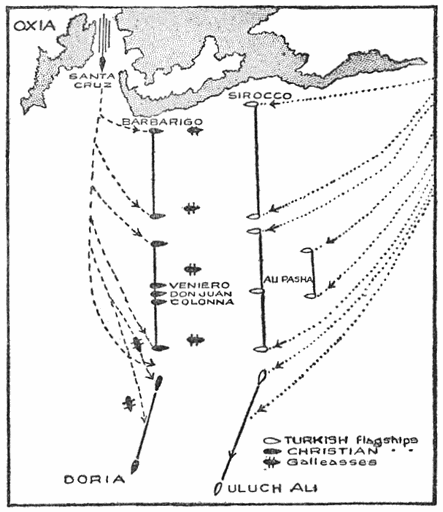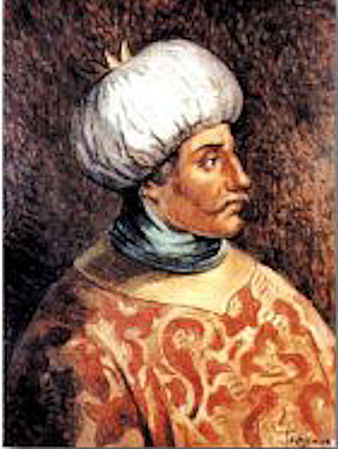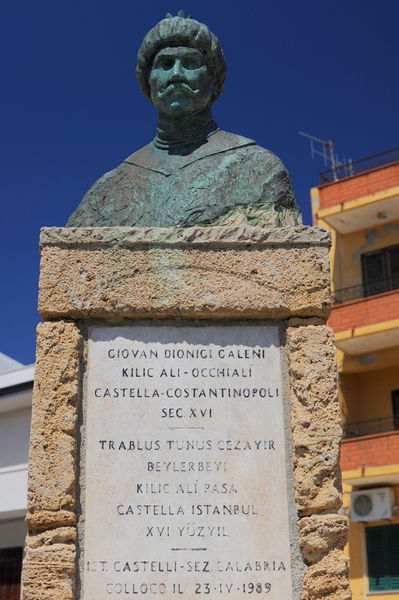<Back to Index>
- Ottoman Viceroy of Egypt Admiral Suluc Mehmet (Siroco) Paşa, 1500+
- Grand Admiral of the Ottoman Fleet Uluš Ali Paşa (Giovanni Dionigi Galeni), 1519
PAGE SPONSOR

Suluc Mehmed Pasha, better known in Europe as Mohammed Sirocco or Mehmed Siroco, was the Ottoman viceroy of Egypt and Governor of Alexandria, in the mid 16th century.
Suluc Mehmed Pasha was appointed admiral in command of the Turkish right at the Battle of Lepanto (1571). Fighting the Christian left, he was wounded and killed.


Uluj Ali (Turkish: Uluš Ali Reis, later Uluš Ali Paşa and finally Kılıš Ali Paşa; born Giovanni Dionigi Galeni; 1519 - 21 June 1587) was an Italian by birth who converted to Islam, became a pirate, and later became an Ottoman admiral (Reis) and Grand Admiral (Kapudan Pasha) of the Ottoman Fleet in the 16th century.
He
was also known by several other names in the Christian countries of the
Mediterranean, and in the literature also appears under various names. He was often, especially in Italy, referred to as Occhiali, and Miguel de Cervantes called him Uchali in chapter XXXIX of his Don Quixote de la Mancha. Elsewhere he was simply called Ali Pasha. John Wolf, in his The Barbary Coast, refers to him as Euldj Ali.
Uluj Ali was born as Giovanni Dionigi Galeni, the son of seaman Birno Galeni and his wife Pippa de Cicco, in the village of Le Castella (near modern Isola Capo Rizzuto) in Calabria, Southern Italy. His father wanted him to receive a religious education, but on 29 April 1536, Giovanni was captured by Ali Ahmed, one of the corsair captains of Barbarossa Hayreddin Pasha, and was forced to serve as a galley slave. After several years, he converted to Islam and joined the corsairs. This was by no means unusual; many Muslim corsairs in this period were converts from Christian lands.
He
was a very able mariner and soon rose in the ranks, gaining sufficient
prize booty to buy a share in a corsair brigantine sailing out of Algiers.
Further success soon enabled him to become the captain and owner of a
galley, and he gained a reputation as one of the boldest corsair reis on the Barbary Coast. He joined Turgut Reis, who was then the most feared corsair in the Mediterranean as well as an Ottoman admiral and Bey of Tripoli. Sailing with Turgut Reis, he also impressed the Ottoman admiral Piyale Pasha, with whom Turgut joined forces on a number of occasions. Due to his success in battles, the administration of the island of Samos in the Aegean Sea was awarded to him in 1550. In 1565 he was promoted to the rank of Beylerbey (Chief Governor) of Alexandria. The same year he joined the Siege of Malta with
the Ottoman Egyptian fleet, and when Turgut Reis was killed during the
siege, Piyale Pasha appointed Uluj Ali to become Turgut's successor as
Bey of Tripoli. Uluj took Turgut's body to Tripoli for burial, assumed
control of the province, and was subsequently confirmed as Pasha of Tripoli by Sultan Suleiman I. In the following years he conducted numerous raids on the coasts of Sicily, Calabria and Naples.
In March 1568, the vice - regency of Algiers fell vacant, and upon the recommendation of Piyale Pasha, Sultan Selim II appointed Uluj Ali to become the Pasha and Beylerbey of Algiers, the most powerful of the increasingly semi - independent corsair states in North Africa. In October 1569 he turned upon the Hafsid Sultan Hamid of Tunis, who had been restored to his throne by Spain. Marching overland with an army of some 5000, he quickly sent Hamid and his forces fleeing and made himself ruler of Tunis. Hamid found refuge in the Spanish fort at La Goulette outside Tunis.
In July 1570, while ostensibly en route to Constantinople to ask the Sultan for more ships and men in order to evict the Spaniards from all of North Africa, Uluj Ali encountered five Maltese galleys, commanded by Francisco de Sant Clement, then the captain - general of the Order's galleys, near Cape Passaro in Sicily and captured four of them. (Sant Clement escaped, but on returning to Malta was condemned, strangled and his body put in a sack and dumped into the harbor.) This victory caused Uluj to change his mind and return to Algiers in order to celebrate. There, in early 1571, he was faced with a mutiny of the janissaries who demanded overdue pay. He decided to put to sea, leaving the mutinous soldiers to take their pay from anyone they could find and rob. Having learned of the presence of a large Ottoman fleet at Coron in the Morea, he decided to join it. It was the fleet commanded by MŘezzinzade Ali Pasha that was to meet disaster at Lepanto a few months later.
On 7 October 1571, Uluj Ali commanded the left flank of Ali Pasha's fleet in the Battle of Lepanto.
He kept his squadron together in the melee, outmaneuvered his direct
opponent, Gian Andrea Doria, and captured the flagship of the Maltese
Knights with its great banner. When the Ottoman defeat became obvious,
he succeeded in extricating his ships, and gathered up the scattered
remaining ships of the Ottoman fleet (some forty galleys and fustas) and
others along the way to Constantinople, where he arrived with 87
vessels. There he presented the great flag of the Maltese Knights to the
Sultan who gave him the honorary title of Kılıš (Sword) and on 29 October 1571 appointed him as Kapudan Pasha (Grand Admiral) and Beylerbey of the Isles. He was subsequently known as Kılıš Ali Pasha.
Piyale Pasha and Kılıš Ali Pasha almost immediately began to rebuild the Ottoman fleet. Kılıš Ali placed special emphasis on the construction of a number of heavier ships modeled upon the Venetian galleasses, heavier artillery for the galleys, and firearms for the soldiers on board. In June 1572, now Chief Admiral, he set out with 250 galleys and a large number of smaller ships to seek revenge for Lepanto. He found the Christian fleet anchored in an inlet of Morea, but his strategy of trying to lure the enemy out and inflicting damage through repeated quick thrusts meant that a full - fledged battle never materialized, because the Christian fleet was too cautious to be trapped and encircled.
In 1573 Kılıš Ali Pasha commanded the naval campaign on the coasts of Italy. In that same year, the regency of Algiers was transferred to Arab Ahmed, and Don Juan of Austria, the victor of Lepanto, recaptured Tunis. In 1574 Kılıš Ali sailed to Tunis with a fleet of 250 galleys and a large army under the command of Cigalazade Sinan Pasha, captured the port fortress of La Goleta on 25 August and city of Tunis on 13 September. He then proceeded to Morocco and on 26 July 1574 constructed an Ottoman castle on the coastline facing Spain. In 1576 he raided Calabria and in 1578 put down another mutiny of the janissaries at Algiers who had assassinated Arab Ahmed. In 1584 he commanded a naval expedition to Crimea. In 1585 he put down revolts in Syria and Lebanon with the Ottoman Egyptian fleet based in Alexandria.
Kılıš
Ali Pasha died on 21 June 1587 in Constantinople. He is buried at the
Kılıš Ali Paşa Mosque (1580), designed by the architect Mimar Sinan.
- He built the Kılıš Ali Paşa Mosque (1580) and Baths (1583) in Istanbul.
- Several warships and submarines of the Turkish Navy have been named after him (Kılıš class fast attack missile boat and Oruš Reis class submarine).
- His statue is in the center square of Le Castella in Calabria, Italy, where he was born.